Last April I went with BThumble to Vanua Balavu Fiji to help with a computer lab at a school there. There is no power plant on that island, although there are a few generators and some small solar power systems in use. We had taken some flourescent lights with us to use with the small solar lighting systems that BT had designed for some of the houses there. Some of them were "trouble lights" of the automotive variety, and some were compact flourescents that Commanda had contributed. As BT put it, the trouble lights lived up to there name, they had a single transistor driver circuit that burned out in short order for all of them. We had also taken some LED lights, which while robust were not likely as efficient as a flourescent. So far as I am aware, the compact flourescents worked out OK.
You can read about that trip here:
http://www.fieldlines.com/story/2007/6/5/85322/76409or at
www.smallsolar.org
In the quest for a better solution to this problem, I have been experimenting with a newer more efficient generation of LED's. First, I obtained some MR16 type bulbs commonly used in track lighting:
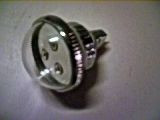
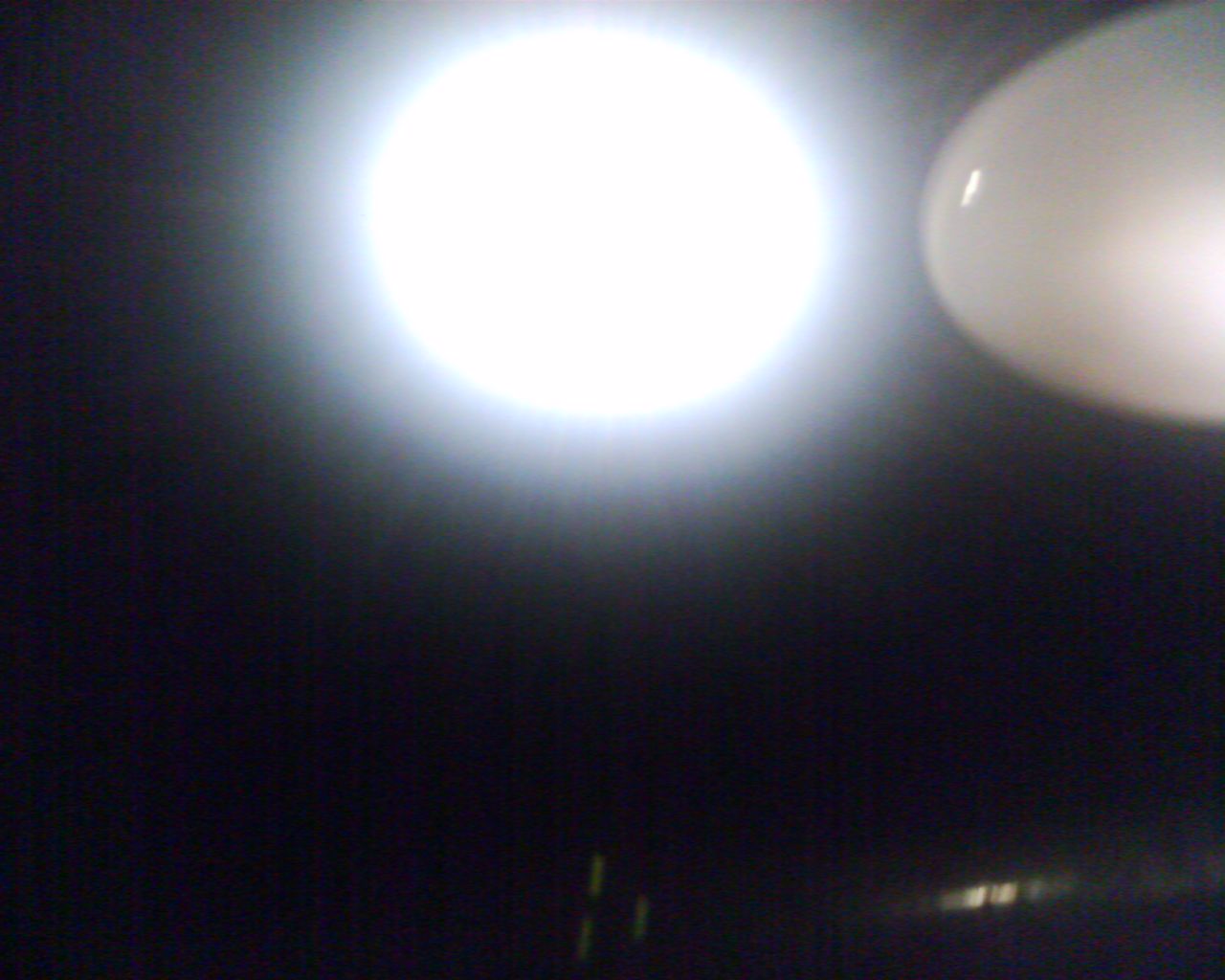
These have a driver built in to limit the current, and have 3 Cree LED's claiming 80 lumens per watt. I was happy with the amount of light that they output at just under 3 volts from my 12V system and have been lighting up a laundry room for a few months now without incident. On the down side is that they are rediculously expensive, so buying a large quantity would be more difficult.
I wound up having 30 boards made up with 3 of the CREE LED's. The LED's were from a bin ranging from about 80 to 87 lumens per watt. The price nearly doubles for the next bin up from there, so for now these will have to do.
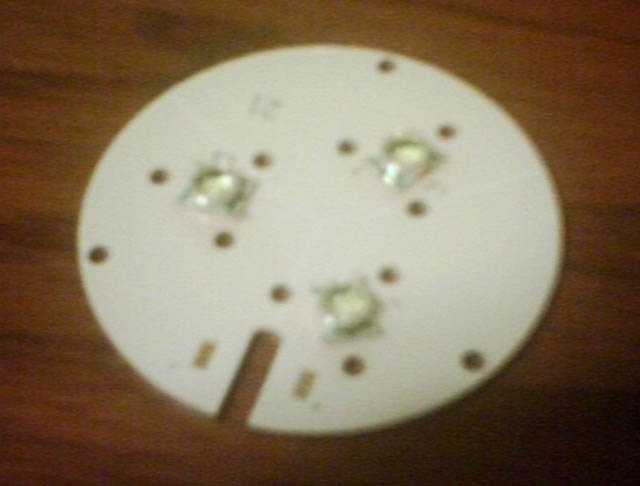
These boards are aluminum with the circuit laminated to them, which should aid in heatsinking and cooling I hope. The boards are similar to, but larger than the boards in the MR16 bulb, and the three Cree LED's are connected in series. I will of course have to come up with a driver circuit for these boards, and hence the purpose of this post. I was hoping for something simple, reasonably efficient, and very reliable.
I am not an electronics guru. I read up on Commanda's posts regarding LED drivers here:
http://www.fieldlines.com/story/2007/4/20/95351/1614
http://www.fieldlines.com/story/2007/4/26/82929/6080
http://www.fieldlines.com/story/2007/5/1/74856/25992
I decided to copy her circuit 4 and attempt to adapt her "Circuit 4" for my situation. I have linked to her sketch here for reference:
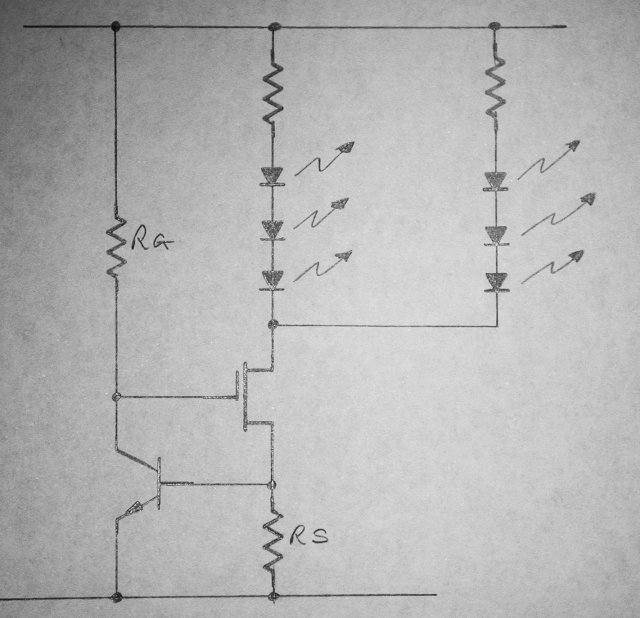
For a test power supply I used 9V batteries in series so that I could pull 9, 18, and 27 volts. For the NPN transistor, I happened to have a few 2N3904's in my box, and for the FET, I had a few 75339P N-chanel mosfets as well. I breadboarded the circuit with 100 ohm LED's for Rg and Rs, since I was powering only one string, I did not use an equalizing resistor.
I found that I got about 11ma through the circuit. I proceeded to reduce the value of Rs, and somwhere along the line I noticed that Rg was getting quite warm (smoke). Upon experimenting with that I ended up increasing that value all the way to 10K ohms, and a little more experimenting would be useful to optimize that resistor value. Now, unlike normal LED's, I am trying to drive a steady 350ma through these. As I reduced the values for Rs, I noticed that the 9V tap never rose above about 60ma.
I also found that I did not have a sufficiently small resistor in my box for the value of Rg. I wound up paralleling several 10 ohm and 15 Ohm resistors. I wound up with 3 @ 10 Ohm, 3 @ 15 Ohm, and one at 56 Ohm, all in parallel. This yielded good results. The circuit drew approximately 345 ma from the 18 and 27 volt taps. The value reduced to the 330's at 27V as the FET got rather hot rather quickly without a heat sink. The LED's were blindingly bright, although I had no way to quantitatively measure the output.
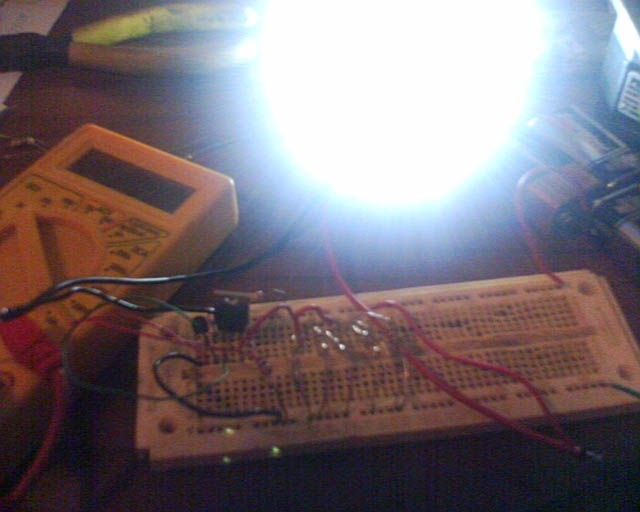
My math puts the value of an equivelant resistor for the ones I had in parallel at 1.93 Ohms or so, so I will probably try to get a few around that value that can handle the current and go from there. With only four components, these drivers should be relatively easy to fabricate.
I am planning to put three or four boards, each board with its own driver, into one fixture to make room lights. That way, if one driver, or one board fails, there will also be a bit of redundancy.
Absent any improvments gleened from here, my next step will be to make a few prototype board and a sample fixture for a longer term test here.
Suggestions welcomed, Rich